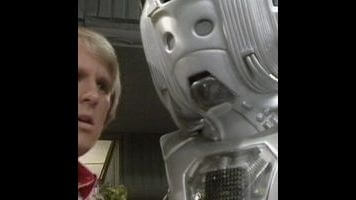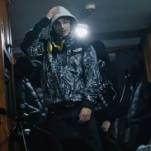Doctor Who (Classic): “The Claws Of Axos”

“The Claws Of Axos” (season 8, episodes 11-14. Originally aired March 13-April 3, 1971)
Once you’ve watched enough Doctor Who to be able to recognize recurring scriptwriters, you start to get a feel for what you can expect from any given story that has their name on the credits. Robert Holmes was Doctor Who’s Alan Moore—a guy who knew the show’s conventions and formulas so well that he could tell a story that tore those conventions apart and reassembled them while still staying true to their spirit. Terry Nation was the series’ first major heavy hitter, and you could always rely on him for solidly paced action-adventure, but left to his own devices he also kept recycling the same ideas over and over again.
And then there’s the team of Bob Baker and Dave Martin, who debuted with the Third Doctor adventure “The Claws Of Axos.” Baker and Martin were mainstays of the show throughout the 1970s, with nine scripts to their credit solo or as a team, including the 10th-anniversary special “The Three Doctors” and “The Invisible Enemy,” which introduced the Doctor’s robot dog K9. They’re responsible for the equivalent of two full seasons of Doctor Who, and as such you have to count them as one of the series’ major creative forces. But the thing about them is that none of those nine stories is really good enough to be a true classic—none have the dazzling dialogue, tightly focused plots or audacious metatextuality that marks the best of Doctor Who. “The Claws Of Axos” certainly doesn’t break that mold—it’s just about the gold standard of adequacy for this era of Doctor Who. It’s certainly entertaining and far from terrible. There’s plenty of exciting action and stuntwork, a genuinely creepy alien monster in the Axons, and it works in season eight’s overarching villain—the Master—in a way that not only justifies his scheming presence but helps set up the most compelling twist in the story: The surprisingly believable idea that the Doctor is just as untrustworthy as he is, and is willing to sell out humanity for his own aims. But that doesn’t excuse its flaws, some of which stem from the limitations of the budget and the special effects but the worst of which are straight-up script problems, namely the badly mishandled subplot about Chinn, the petty-tyrant bureaucrat whose greed plays right into the Axons’ hands (and tumorous tentacles), and the near-total sidelining of the pretty sizable cast of regular co-stars in favor of a one-off side character. It’s not particularly bad, especially by Doctor Who standards, but if “City Of Death” is a home run and “The Twin Dilemma” is a foul tip that hits the batter in the face and breaks his nose, “The Claws Of Axos” is a base hit, solid and respectable but unexceptional.
Which is, I think, about what the show was aiming for in season eight. The previous season, Jon Pertwee’s debut as the Third Doctor, had been far more ambitious, consciously aiming to shake the show out of its monster-of-the-week, base-under-siege formula by injecting more complex characterizations and political themes into the mix. That led to a rather grim and serious tone, with “The Silurians” ending in an arguably needless massacre and “Inferno” with the destruction of the Earth (well, an alternate one, anyway). Season eight pulled back from that and went for a lighter tone, which was most obvious in the two major cast additions: the Doctor’s bubbly new assistant Jo Grant and his new full-time nemesis, the Master, a character so self-consciously steeped in melodramatic villainy that his mere presence announced that Doctor Who wasn’t going to take itself quite so seriously anymore. And in fact with all his scheming and conniving and mustache-twirling, the over-reliance on the Master meant that Doctor Who danced dangerously on the edge of kitschy camp. Roger Delgado’s performance deserves a lot of credit for staying on the right side of that line—he embraces the Master’s larger-than-life, almost vaudevillian personality without letting it get overly broad, something that neither Anthony Ainley nor John Simm did when they took over the role in later years. Of course, it’s certainly possible for a TV show to mix an underlying seriousness with moments of wacky humor or self-consciously over-the-top action without ruining either mood (see: Joss Whedon’s filmography), and in his best moments the Master works on both levels—the scene where he jumps onto a moving truck and hypnotizes the driver through the rear-view mirror is as good as any Bond movie villain, but although I got a good laugh out of him disguising his way past Sgt. Benton to gain entry to the Doctor’s TARDIS, that rubber mask is Scooby Doo-level stuff.
The Axons don’t have anything close to the Master’s charisma, but they make up for it in conceptual horror. Although they pretend to be golden-skinned and angelic, it’s a ruse to hide their true motives. Much like the Thing from John Carpenter’s movie, the Axons, their ship, and their Axonite are all one living mass of psychedelic tumors, seeking only to corrupt and devour, a strange and repulsive living embodiment of greed. Their offer of a seemingly inexhaustible source of power, Axonite, turns out to be both a literally cancerous blight that threatens to devour the Earth, and one that gains power from the corruption and greed of human beings when they use Chinn to help spread Axonite worldwide. Though it isn’t mentioned outright, there’s some thematic resonance with the then-topical 1970s energy crisis, with the twist that instead of humans exploiting and ruining the Earth in a voracious desire for oil, this new energy source can do the exploiting and ruining all on its own. (It’s a nice touch that Chinn is actually too corrupt for the Axons’ purposes when he inadvertently stops the spread of Axonite by hoarding it all for Britain.) They’re slightly let down by the visuals, which don’t quite capture some of Baker and Martin’s more subtle ideas—the original concept was that the area around the Axon ship would grow progressively more grey and dead as it sucked the life from its surroundings, much like the blight in H.P. Lovecraft’s “The Colour Out Of Space.” And if their tentacle-laden forms are a little underwhelming in the long shots where it’s all too obvious they’re just guys in rubber suits, up close they’re effectively unnerving.
The subplot involving their unknowing pawn, Chinn, is less effective. His buffoonish officiousness and blustery bullying is laid on a little too thick in a failed attempt to make his character work simultaneously as legitimate threat and ridiculous comic relief. But what’s worse is that sometime around the end of the third episode, Baker and Martin seem to lose interest in Chinn’s storyline, which peters out into nothing. In the final episode, the only thing of note he does is to eat a chicken leg while complaining that he doesn’t want to get blamed for any of this.
Filer, on the other hand, just seems superfluous. It’s not so much that Paul Grist does badly in the role or that the character doesn’t play an important part in the story, it’s that nothing Filer does couldn’t have been done equally well by one of the ongoing characters that the audience has more emotional investment with. Jo’s sense of betrayal might have stung more deeply if she’d been the one who was most suspicious of what he was up to in the fourth episode. The shock of seeing the Master not (apparently) in league with the villains but at their mercy would be greater if he’d been discovered by someone who’d actually met him before. And if you need someone who can get into a fistfight with the Doctor and his own evil duplicate, you’re spoiled for choice—there’s the Brigadier, Captain Yates and Sergeant Benton just sitting around under house arrest. On the other hand, none of those guys have Filer’s slightly shaggy, stylish helmet-hair ‘do, which makes it possible to imagine that he’s actually the Trololo guy, here to repel alien invaders with bizarre Russian lounge music.








































